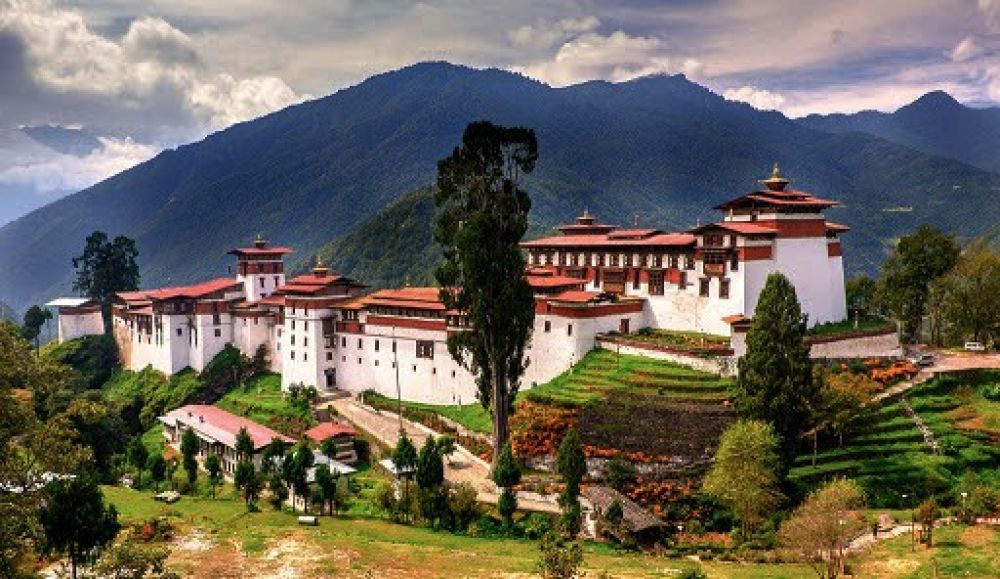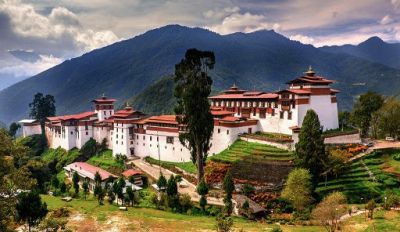

Trongsa Dzong is a majestic fortress that dates back to the 17th century. It is known for its strategic location, which provided control over the trade routes between eastern and western Bhutan during historical times. The architecture of the dzong encapsulates a blend of spiritual significance and military prowess, as it was the seat of power for the Wangchuck dynasty before they became the rulers of Bhutan. A visit to this dzong offers a journey through Bhutan's rich heritage, with multiple temples, intricate woodwork, and ancient murals. One can also enjoy the grand panoramic views of the deep valleys that surround the fortress. The journey through the dzong reveals its historical importance in consolidating Bhutan's unification and serves as a testament to the country's Buddhist culture.
Although the Tiger’s Nest, or Paro Taktsang, is not located within Trongsa, it is one of Bhutan's most iconic activities and well worth the travel from Trongsa. The trek to Tiger's Nest is both spiritually and physically invigorating, as it leads adventurers up the steep paths to an elevation of approximately 3,120 meters (10,240 feet). This mystical monastery clings to a sheer cliff face and is said to be where Guru Rinpoche, the patron saint of Bhutan, meditated for three months. The hike takes one through lush forests, adorned with prayer flags and breathtaking views. Upon reaching the top, visitors are greeted with an unparalleled view of this architectural marvel, which is an essential pilgrimage site for every Bhutanese and a profound experience for visitors.
Ta Dzong is a cylindrical stone structure originally built as a watchtower that now houses the Royal Heritage Museum. The museum is dedicated to preserving the rich cultural heritage of Bhutan and provides insight into the history of the royal family, unique artifacts, traditional costumes, and religious relics. Overlooking the Trongsa Dzong and valley, the museum offers a detailed narrative, which complements the physical exploration of the surrounding dzongs and temples. Visitors get to witness a collection of rare and precious items which include centuries-old thangka paintings, swords, and traditional armor. The museum serves as a gateway to understanding Bhutanese culture, and its role in shaping the country. It is an educational resource that bridges the past with the present, and a must-visit for any culture and history enthusiast.
Located en route from Trongsa to the town of Jakar, the Chendebji Chorten is a prominent stupa that was built in the 18th century by Lama Zhida to subdue an evil spirit that had manifested as a demon. This significant religious monument is designed in the style of the Boudhanath stupa in Nepal, with eyes painted on four sides of the tower. Similar to other chortens, it embodies the elements and aspects of Buddhist philosophy and offers a site for meditation and circumambulation. The journey to Chendebji Chorten is picturesque, with the backdrop of rolling hills and a river, creating a serene environment for both reflection and exploration. It is a testament to the blending of Bhutanese and Nepalese architectural influences and a symbol of peace and harmony.
Thruepang Palace is a significant historical building situated in Trongsa, as it is the birthplace of the Third King of Bhutan, His Majesty King Jigme Dorji Wangchuck. The palace is a modest unassuming structure that gives visitors a glimpse into the royal family's past. Though not as grand as some other palaces, it holds great sentimental value for the Bhutanese people. Visitors can admire the traditional Bhutanese architecture and learn about the life of the Third King, who is often referred to as the Father of Modern Bhutan for the reforms he implemented during his reign. Exploring Thruepang Palace allows tourists to connect with the nuanced history of the Bhutanese monarchy and understand the country's transformation under the king's rule.
A guided village walk around Trongsa provides a window into the daily life of the local Bhutanese. These walks typically include visits to traditional homes, interaction with local families, and insight into the agricultural lifestyle of the residents. The region is known for its beautiful terraced fields and farmhouses, which are particularly stunning during the months of paddy cultivation. Visitors can witness traditional Bhutanese farming practices and might even have the chance to participate in some hands-on activities like milking cows or churning butter. This immersive experience often includes a meal prepared with locally sourced ingredients, offering a taste of the authentic Bhutanese cuisine. It's an enriching encounter that showcases the simplicity and hospitality of life in rural Bhutan.
The Black Mountains, or Jigme Singye Wangchuck National Park, offers some of the most scenic trails in Bhutan. The park is a diverse mix of landscapes ranging from subtropical forests to alpine zones. Hikers here can witness the rich biodiversity of the area, including several species of flora and fauna that are indigenous to Bhutan. Trails will take you past gushing waterfalls, crystal-clear lakes, and offer opportunities for bird watching, including sighting the rare Black-Necked Crane. The hike is typically moderate in difficulty, but it requires a good level of fitness. The tranquility of the Black Mountains provides a perfect escape for nature lovers and those looking to connect with the pristine environment of Bhutan.
Experiencing a cultural performance is a highlight for many visitors to Trongsa. These performances exhibit traditional Bhutanese music, dance, and attire. Dancers in elaborate costumes perform choreographed movements that tell stories of the country's history, myths, and folklore, usually accompanied by musicians playing indigenous instruments. The dramatic mask dances, known as Cham, are particularly striking. Such performances provide insights into the Bhutanese way of life and are a testament to the country's celebration of its cultural heritage. Performances are often held during local festivals, but private shows can be arranged through local tour operators for those who wish to enjoy this colorful aspect of Bhutanese culture during their visit.
Archery is Bhutan’s national sport, and what better way to experience it than by trying your hand at it in Trongsa. Tourists can either observe or participate in this traditional activity, often conducted in local sports grounds or archery ranges. A local guide or instructor can introduce the equipment and basic techniques. For those watching, the excitement comes not just from the skillful display of archery but also from the celebrations and banter that accompany it. Competitions are lively, with team members often singing and dancing to distract the opposing team or to celebrate a good shot. Participating in or watching an archery session allows visitors to engage with Bhutanese culture in a unique and interactive way.
Rigsum Goenpa Monastery stands on a hill above Trongsa Dzong, offering stunning views of the Trongsa valley and the dzong itself. The hike to Rigsum Goenpa is relatively easy, winding through pine forests filled with the chanting of birds and the rustle of leaves. The monastery is a peaceful retreat, known for its beautiful frescoes and statues of the Rigsum Gonpo—three bodhisattvas of Buddhism: Avalokiteshvara, Manjushri, and Vajrapani. The monastery is also a learning center for monks, and visitors often get the chance to interact with the resident monks and learn about their way of life. This hike is particularly recommended for those seeking tranquility away from the tourist path, and it offers a chance to observe daily religious practices in a serene environment.
